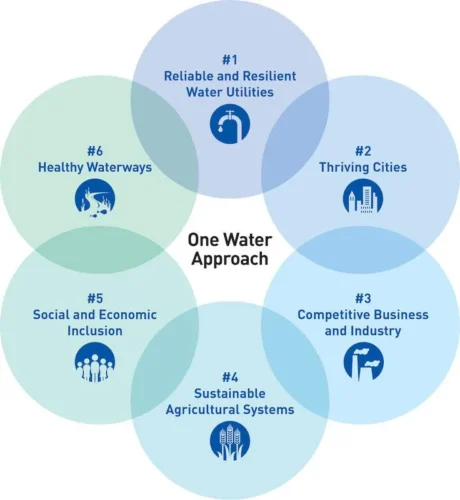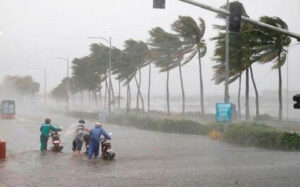Utilities around the nation embrace a new kind of innovation
Figure 1: The six goals of the one water approach. Stakeholders—whether public or private—must keep these six goals in mind when addressing issues of water that affect them and the communities in which they are located.
The 21st century is bringing more and more complex challenges and the engineers and operators know the situation better than anyone. Old buildings and constructions are required to be under stricter control. The changes in climate can always be seen first in the water field and it raises awareness in the glooming future. Nowadays, a lot of industrial particles can be found in the water system, which can have bad effects on public health. The government fund for renovating infrastructure is decreasing, a generation of the workforce in the water industry is coming close to retirement, etc. A new way of thinking, acting is required to solve these urgent problems.
Beyond the current situation
Trusted systems and infrastructure that have worked efficiently and effectively—out of sight, out of mind—in pipes beneath our cities no longer are enough. The silent culture of the water industry is over.
The habit of believing blindly in the infrastructure system that is placed underground, nowhere to be seen and hoping that it would work just fine without actually knowing its real conditions is not good enough at this time era. It is time for the water industry to speak up and be seen.
Thankfully, water management in the U.S. is entering another era of change and innovation. There is no shortage of new ideas and technology development. Engineers are doing what they do best: designing and building systems to address our most pressing needs. Advances in anaerobic membrane bioreactor technology have shortened hydraulic retention times and promoted valuable biogas production. Robotic sensors can detect areas with high opioid levels in wastewater flows.
Yet the success of these solutions depends on more than their technical merit; the way we implement them in a rapidly changing society matters. Our water resources, systems and infrastructure have reached a tipping point, as well as the way we innovate and manage water.
The One Water Movement
“One water” is the recognition that all water has value, and it is a movement to actively manage it in a sustainable, integrated and inclusive way. This involves complex and interwoven solutions with partners across jurisdictions. One water is a breakdown of historical silos within the water sector, but also among all the other stakeholders who influence, and are influenced by, the management of water resources. This includes community and business leaders, industries, farmers, environmental advocates, conservationists, policymakers, academics and others.
The movement calls utilities to step up as anchor institutions within their communities to achieve six goals (Figure 1):
- Reliable and resilient water utilities;
- Thriving cities;
- Competitive business and industry;
- Sustainable agriculture systems;
- Social and economic inclusion; and
- Healthy waterways.
Why One Water?
Water is a cornerstone for each of these goals, and many of these goals are interdependent. Taken together, one water can lead to tangible progress in how we manage water resources in the U.S., but water managers and operators cannot achieve any one of these goals alone.
As rates increase, so do community expectations for the accessibility and transparency of their utilities. This complexity brings forth the need to work across boundaries and improve the public’s understanding and support of innovations in the water sector. Utilities must engage with their customers; engineers are learning the importance of communicating their technical work, and communities are holding their utilities accountable.
One Water In Action
One water management demands everyone play an important role in securing a sustainable water future. The good news is, all around the country, we are seeing silo-busting examples of this approach.
The Art of Phosphorus Recovery. The Metropolitan Water Reclamation District of Greater Chicago (MWRD) operates the largest phosphorus recovery facility in the world, with the annual capacity to remove 1,500 tons of phosphorus and convert it into a slow-release fertilizer.
While accomplishing this feat was a game-changer for regional water quality, the MWRD still needed an effective way to explain the value of this technical process to the public. MWRD partnered with a group of artists, who created an interactive game using augmented reality to help the public understand the process of phosphorus recovery as a means to spark curiosity and engagement rather than just provide people with more data. The game built awareness around a critical water quality issue highlighted an innovative new solution and shared opportunities for engaging the public. Art experiences can provide a human-centred way for people to understand technical or scientific processes and systems.
Equitable Solutions for Water Scarcity. Rainwater harvesting is a simple, sustainable strategy to expand Tucson, Ariz., conservation ethics and encompass alternative water supplies; however, one in five families in Tucson live below the poverty line. There are clear racial disparities‚ and the city is home to a large undocumented immigrant community. Widespread implementation of a technical solution demanded working within an inclusive community context.
Tucson Water developed the Low-Income Rainwater Harvesting Program, which qualifies households for zero-interest loans to build systems, in addition to offering eligibility for an existing rebate. The utility partnered with Sonoran Environmental Research Institute (SERI) to conduct outreach and education around the benefits of rainwater harvesting. By using longstanding connections with vulnerable communities, the program reaches the households that need it most. SERI guides customers through each step of the process, from design and purchasing materials to hiring local contractors to install the systems. Such partnerships tap technical and community expertise to achieve multiple one water goals.
Multifaceted Agriculture Innovations. Responding to flooding concerns and potential nitrate in drinking water, the city of Cedar Rapids, Iowa, and 15 partners applied for funding from the U.S. Department of Agriculture Natural Resource Conservation Service’s Regional Conservation Partnership Program. The five-year project connects downstream water consumers with upstream agricultural producers to improve water quality, reduce flood risk and improve soil health.
Initial partnership efforts focus on five watersheds in the larger Cedar River region and build on two state-funded water quality projects already underway. The first step—led by the Iowa Soybean Assn.—was to develop watershed plans. In the next phase, efforts will focus on implementation using bioreactors, saturated buffers and cover crops for the greatest impact on water quality. Additionally, partners will focus on outreach to encourage greater adoption of promising practices. When landowners and producers upstream work together with cities downstream in water management, everyone benefits.
Transformational Leadership
One water is the future we need, but what does it take to drive these kinds of technical and social innovations? How do we institutionalize them for long-term change?
Solutions that embrace a one water approach require transformation. Reaching beyond the status quo presents utility managers and engineers with unique challenges. Transformation must occur in the way we think about, design and implement solutions.
In 2019, the U.S. Water Alliance embarked on a journey to understand who is leading the one water movement, and specifically, how they do it. Through interviews with top leaders across the water industry, the U.S. Water Alliance is building a framework for capacities—knowledge, skills and attitudes—that drive one-water strategies.
Top takeaways from this work indicate three things:
- Transformation requires an opening of the underlying culture of a utility. The minds, hearts and habits of utility employees, from top to bottom, must shift toward one water.
- Leaders across the nation can enable one water transformation through a set of seven capacities they embody and develop among utility employees.
- The next generation of water leaders can develop these capacities to accelerate progress towards a one water future.
The U.S. Water Alliance will release Seven Capacities for One Water Change Leadership at the One Water Summit 2019 in Austin, Texas, this September.
“[Traditionally] we design, build and construct infrastructure to treat wastewater,” said Michael Mucha, chief engineer and director of the Madison Metropolitan Sewerage District. “The shift we’ve gone through is, finding non-infrastructure solutions to protect public health and the environment. We help preserve a future for our children’s children. It is something we can all work towards.”
Leaders like Mucha will be key to the transformational change needed to accelerate and spread best practices for managing water. This can create a one water future, and the U.S. Water Alliance awaits new leaders and innovators to build that future.
Source: Water & Waste Digest Magazine






